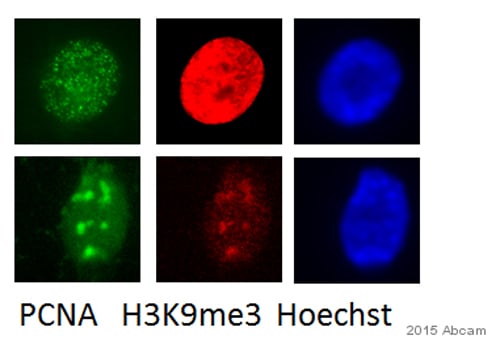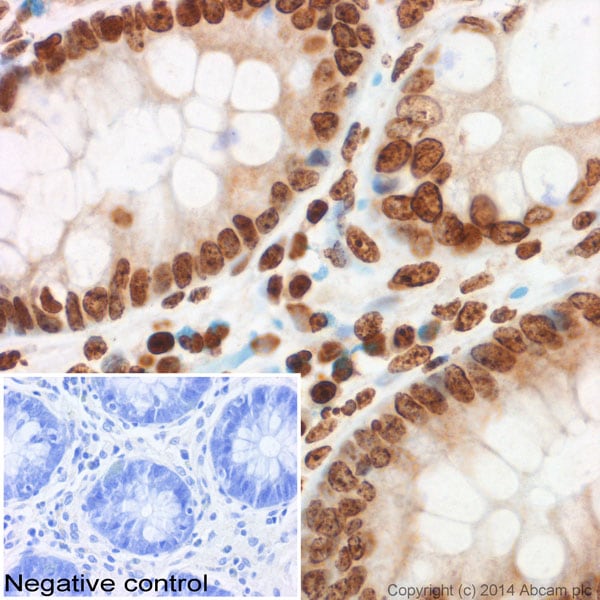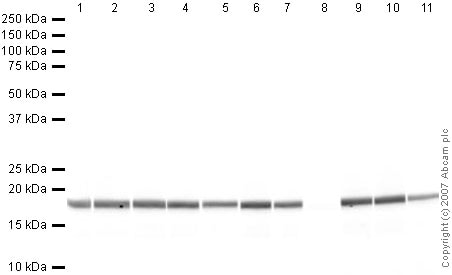Anti-Histone H3 (tri methyl K9) antibody - ChIP Grade (ab8898)
Key features and details
- Rabbit polyclonal to Histone H3 (tri methyl K9) - ChIP Grade
- Suitable for: WB, IHC-P, ICC/IF, ChIP
- Reacts with: Mouse, Cow, Human
- Isotype: IgG
Overview
-
Product name
Anti-Histone H3 (tri methyl K9) antibody - ChIP Grade
See all Histone H3 primary antibodies -
Description
Rabbit polyclonal to Histone H3 (tri methyl K9) - ChIP Grade -
Host species
Rabbit -
Specificity
Histone H3 (tri methyl K9) antibody (ab8898) is specific for Histone H3 tri methyl Lysine 9. Shows slight cross-reactivity with tri methyl K27, which shares a similar epitope (please see Western blot image). Does not react with mono or di methylated K9.
-
Tested Applications & Species
See all applications and species dataApplication Species ChIP HumanICC/IF MouseHumanIndian muntjacIHC-P HumanWB Cow -
Immunogen
Synthetic peptide within Human Histone H3 aa 1-100 (N terminal) (tri methyl K9) conjugated to keyhole limpet haemocyanin. The exact sequence is proprietary.
(Peptide available asab1773) -
Positive control
- ChIP: U2OS cells, mouse ES cells. WB: Calf Thymus Histone Preparation Nuclear Lysate. IHC-P: Normal human colon. ICC: Mouse 3T3MEF, Indian muntjac fibroblast cells, HeLa cells, Mouse Embryonic Stem cells.
-
General notes
Every new batch of ab8898 is tested in house in ChIP. Learn about ChIP assay kits, other ChIP antibodies, protocols and more in the ChIP assay guide.
Images
-
Chromatin was prepared from U2OS cells according to the Abcam X-ChIP protocol. Cells were fixed with formaldehyde for 10 min. The ChIP was performed with 25 µg of chromatin, 2 µg of ab8898 (blue), and 20 µl of protein A/G sepharose beads. No antibody was added to the beads control (yellow). The immunoprecipitated DNA was quantified by real time PCR (Taqman approach for active and inactive loci, Sybr green approach for heterochromatic loci). Primers and probes are located in the first kb of the transcribed region.
-
 ChIP - Anti-Histone H3 (tri methyl K9) antibody - ChIP Grade (ab8898) This image is courtesy of an anonymous abreview.
ChIP - Anti-Histone H3 (tri methyl K9) antibody - ChIP Grade (ab8898) This image is courtesy of an anonymous abreview.X-Chip assay was performed using nuclear lysates prepared from mouse ES cells. Crosslinking was done for 15 minutes in 1% formaldehyde. Primary antibody was incubated first with peptides ab7228, ab1342, ab1782, ab1773, ab1772 and ab1771 in a chip competition assay and then used in chip at 0.0133µg/ µg chromatin (chip sonication buffer) and incubated with sample for 24 hours at 4°C.
Positive control: ChIP coupled with a peptide competition assay to validate the specificity of the antibody.
Negative control: Genomic region (chr10:79154149-79155200) with no evidence of H3K9me3.
RT-PCR detection method was used.
Polrmt: PCR primers situated in the coding regions of Polymerase (RNA) mitochondrial (DNA directed).
Agrn: PCR primers situated in the coding regions of Agrin
-
All lanes : Anti-Histone H3 (tri methyl K9) antibody - ChIP Grade (ab8898) at 1 µg/ml
Lane 1 : Calf Thymus Histone Preparation Nuclear Lysate
Lane 2 : Calf Thymus Histone Preparation Nuclear Lysate withHuman Histone H3 (unmodified) peptide (ab7228) at 0.5 µg/ml
Lane 3 : Calf Thymus Histone Preparation Nuclear Lysate withHuman Histone H3 (mono methyl K4) peptide (ab1340) at 0.5 µg/ml
Lane 4 : Calf Thymus Histone Preparation Nuclear Lysate withHuman Histone H3 (di methyl K4) peptide (ab7768) at 0.5 µg/ml
Lane 5 : Calf Thymus Histone Preparation Nuclear Lysate withHuman Histone H3 (tri methyl K4) peptide (ab1342) at 0.5 µg/ml
Lane 6 : Calf Thymus Histone Preparation Nuclear Lysate withHuman Histone H3 (mono methyl K9) peptide (ab1771) at 0.5 µg/ml
Lane 7 : Calf Thymus Histone Preparation Nuclear Lysate withHuman Histone H3 (di methyl K9) peptide (ab1772) at 0.5 µg/ml
Lane 8 : Calf Thymus Histone Preparation Nuclear Lysate withHuman Histone H3 (tri methyl K9) peptide (ab1773) at 0.5 µg/ml
Lane 9 : Calf Thymus Histone Preparation Nuclear Lysate withHuman Histone H3 (mono methyl K27) peptide (ab1780) at 0.5 µg/ml
Lane 10 : Calf Thymus Histone Preparation Nuclear Lysate withHuman Histone H3 (di methyl K27) peptide (ab1781) at 0.5 µg/ml
Lane 11 : Calf Thymus Histone Preparation Nuclear Lysate withHuman Histone H3 (tri methyl K27) peptide (ab1782) at 0.5 µg/ml
Lysates/proteins at 0.5 µg per lane.
Secondary
All lanes : IRDye 680 Conjugated Goat Anti-Rabbit IgG (H+L) at 1/10000 dilution
Performed under reducing conditions.
Predicted band size: 15 kDa
Observed band size: 17 kDa why is the actual band size different from the predicted?
Lane 8 shows that Rabbit polyclonal to Histone H3 (tri methyl K9) is blocked by the addition of the immunizing peptide (ab1773). Cross-reactivity with Histone H3 peptide - tri methyl K27 (ab1782) is also shown in Lane 11. -
 Immunocytochemistry/ Immunofluorescence - Anti-Histone H3 (tri methyl K9) antibody - ChIP Grade (ab8898) This image is a courtesy of Anonymous Abreview
Immunocytochemistry/ Immunofluorescence - Anti-Histone H3 (tri methyl K9) antibody - ChIP Grade (ab8898) This image is a courtesy of Anonymous Abreviewab8898 staining H3K9me3 in mouse 3T3MEF by ICC/IF (Immunocytochemistry/immunofluorescence). Cells were fixed with PFA, permeabilized with CSK buffer and MeOH and blocked with 5% BSA for 30 minutes at 21°C. Samples were incubated with primary antibody (1/500 in PBS +5% BSA + 01% Tween20) for 2 hours at 21°C. An undiluted Alexa Fluor® 546-conjugated Goat anti-rabbit IgG was used as the secondary antibody.
-
 Immunohistochemistry (Formalin/PFA-fixed paraffin-embedded sections) - Anti-Histone H3 (tri methyl K9) antibody - ChIP Grade (ab8898)
Immunohistochemistry (Formalin/PFA-fixed paraffin-embedded sections) - Anti-Histone H3 (tri methyl K9) antibody - ChIP Grade (ab8898)IHC image of ab8898 staining Histone H3 (tri methyl K9) in normal human colon formalin-fixed paraffin-embedded tissue sections*, performed on a Leica Bond. The section was pre-treated using heat mediated antigen retrieval with sodium citrate buffer (pH6, epitope retrieval solution 1) for 20 mins. The section was then incubated with ab8898, 1/400 dilution, for 15 mins at room temperature and detected using an HRP conjugated compact polymer system. DAB was used as the chromogen. The section was then counterstained with haematoxylin and mounted with DPX. No primary antibody was used in the negative control (shown on the inset).
For other IHC staining systems (automated and non-automated) customers should optimize variable parameters such as antigen retrieval conditions, primary antibody concentration and antibody incubation times.
*Tissue obtained from the Human Research Tissue Bank, supported by the NIHR Cambridge Biomedical Research Centre
-
 Immunocytochemistry/ Immunofluorescence - Anti-Histone H3 (tri methyl K9) antibody - ChIP Grade (ab8898)These images were kindly submitted by Prof Bryan Turner, University of Birmingham. Undifferentiated Mouse Embryonic Stem cells or cells differentiated for 7 days were incubated with ab8898. The staining is specific for centromeric heterochromatin on metaphase chromosomes.
Immunocytochemistry/ Immunofluorescence - Anti-Histone H3 (tri methyl K9) antibody - ChIP Grade (ab8898)These images were kindly submitted by Prof Bryan Turner, University of Birmingham. Undifferentiated Mouse Embryonic Stem cells or cells differentiated for 7 days were incubated with ab8898. The staining is specific for centromeric heterochromatin on metaphase chromosomes. -
 Immunocytochemistry/ Immunofluorescence - Anti-Histone H3 (tri methyl K9) antibody - ChIP Grade (ab8898) This image is courtesy of Kirk McManus in the lab of Michael Hendzel, Univeristy of Alberta
Immunocytochemistry/ Immunofluorescence - Anti-Histone H3 (tri methyl K9) antibody - ChIP Grade (ab8898) This image is courtesy of Kirk McManus in the lab of Michael Hendzel, Univeristy of AlbertaIndian muntjac fibroblast cells stained with anti-Histone H3 tri methyl K9, ab8898, (green, left panel, deconvolution image; red, right panel, epifluorescence image).
The centromeres are enriched in Histone H3 tri methyl K9. There are also additional bands that occur throughout the chromosomes. Note that these images are taken in situ and are imaged under conditions where distinct cytogenetic-like banding patterns have not previously been possible to visualize (e.g., several acetylated antibodies have been reported to be associated with chromosome bands but, although not homogenously distributed along in situ chromosomes, they do not generate distinct banding patterns). -
 Immunocytochemistry/ Immunofluorescence - Anti-Histone H3 (tri methyl K9) antibody - ChIP Grade (ab8898)
Immunocytochemistry/ Immunofluorescence - Anti-Histone H3 (tri methyl K9) antibody - ChIP Grade (ab8898)ICC/IF image of ab8898 stained HeLa cells. The cells were 100% methanol fixed (5 min) and then incubated in 1%BSA / 10% normal goat serum / 0.3M glycine in 0.1% PBS-Tween for 1h to permeabilise the cells and block non-specific protein-protein interactions. The cells were then incubated with the antibody (ab8898, 0.1µg/ml) overnight at +4°C. The secondary antibody (green) was ab96899, a goat anti-rabbit DyLight® 488 (IgG; H+L) used at a 1/250 dilution for 1h. Alexa Fluor® 594 WGA was used to label plasma membranes (red) at a 1/200 dilution for 1h. DAPI was used to stain the cell nuclei (blue) at a concentration of 1.43µM.




















